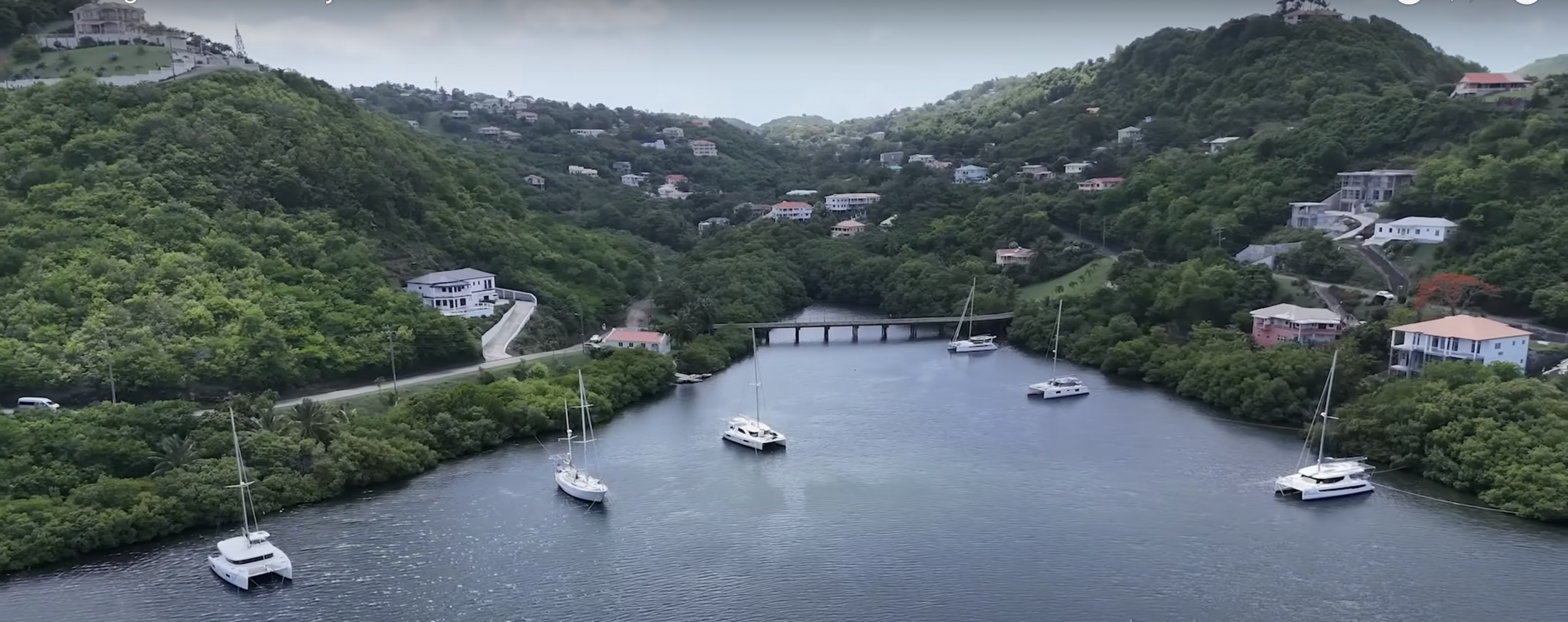
When we were planning our Atlantic crossing, there were two big things I had in mind: one was us safely getting to the Caribbean, but the other was “Hurricanes”. Overall, the UK and Mediterranean are pretty stable when it comes to winds (side from the occasional “Medicane”). However, when you get to the Caribbean, it’s a certainty that there will be Hurricanes and they can be devastating.
The first indication of this new reality of this was that our insurance policy on the boat stipulated a “hurricane zone” we had to be out of by the 1st June and we got introduced to the concept of “Named Wind Exclusion”. Essentially when you’re in the UK and you hear about “Storm Emily” or “Hurricane Ivan”, you take an interest, but when you’re on a boat, the fact they’ve given it a name takes on a whole new meaning. This is because insurance companies have a whole bunch of clauses about them in your policy. If you get struck by a named wind, your policy could be void by that system, or your excess / deductible could now be two of three times more if you claim for damages.
With all that in mind, we got to Barbados in January and had a great few months sailing through the Caribbean, but come 1st June we followed our plan to be the required distance south (12.4 degree North if you’re interested) and base ourselves in Grenada for the Hurricane season. This is standard practice with the sailors out here and 100’s of boats descends; either to be lifted out and left in a yard or just hang out with other cruisers.
Given this annual migration, there is a large community of sailors all just hanging out and you get to bump into people you haven’t seen for a while. “Happy Hour” is a way of life in the local bars as is smoking large quantities of weed, going to open mic nights, bingo, card games and getting shared busses to the supermarkets. This is the life we started settling into (albeit we didn’t think we’d be able to do it all summer). Standard early conversations centre around when your insurance required you to be south, where the imaginary line is you need to be south of and what you’d heard about past hurricanes.
So it just so happens that one morning I was chatting to our friend John about wing foiling and whether there was enough wind when he said that there could be soon plenty as there was one of “those swirly things” forming in the Atlantic. A casual look at our forecasting apps showed some thunderstorms off Cape Verde and the forecast showed it could form into a strong wind system that would blow up towards Barbados in a week or so. Something new to watch.
Checking the next day, and it was still showing the same, although maybe a bit stronger. But all the talk was that this was way too early in the season for hurricane of any size, and nothing had hit Grenada for 20 years. However, somebody said to check the National Hurricane Watch website (NOAA). They had a little yellow “X” in the Atlantic with a note saying that there was around a 50% chance of it forming into a tropical depression within 7 days along with some winds to watch (but nothing major).
The next couple of days were spent watching the chart as percentage of a blow increased from 50 to 60 up to 80 to 90%. However, the track still had it going North closer to Barbados, but we were getting a bit more concerned.
I’m now getting increasing familiar with a concept called the “Cone of Uncertainty”. Basically, a hurricane will do what the hell it wants, but generally it’ll only deviate from its track by a few degrees a day. As the models can’t really agree on exactly where it’s going, they take an average and then show how much it could move from this. What was clear is that despite the models showing the system going north, we were still within that cone.
It was Thursday and Tatum and I had a decision to make. The system was 4 days out – would we say in Grenada or run. Our only real option was to sail south down to Trinidad, which has a reputation of being a bit dodgy, bureaucratic to get into and not having many good anchorages. Running north wasn’t an option and Grenada was generally accepted as being one of the best places to ride out a hurricane. We knew there was a very sheltered bay called “Egmont” just around the corner from us if we needed it, so we made the call to stay, but would review it daily. In the meantime, it was watch and wait.
Friday and the forecast was getting worse. The system was still tracking north of us, but it was pretty certain it would tip from being a depression into a storm or a Cat 1 Hurricane (the lowest grade). One of our friends (Nigel and Sara) decided to move into Egmont and after a bit of a discussion, we thought it prudent to do the same, so we were sure we would have a space in there. So we pulled up our anchor and motored the hour or so to get there. We also decided to make water on the way so our freshwater tanks were full.
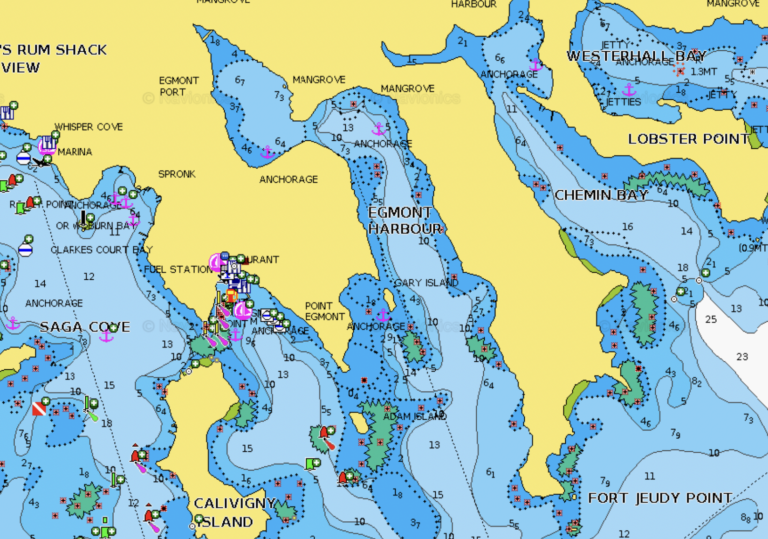
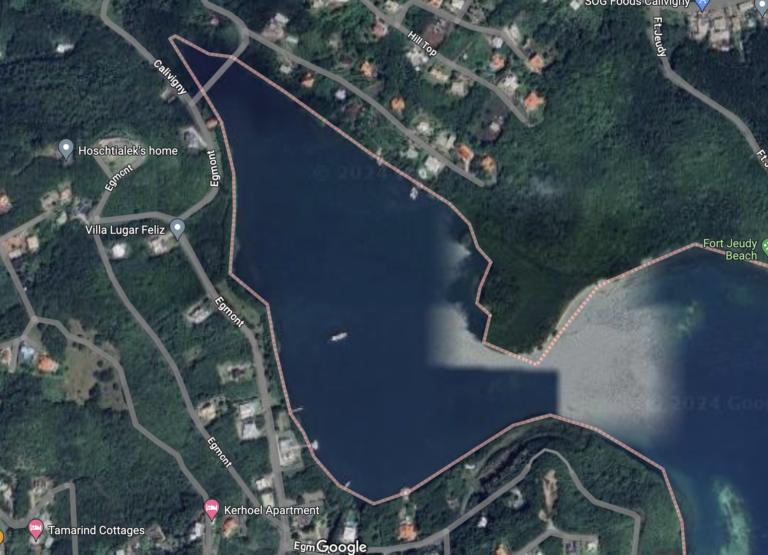
Egmont is really quite cool. You navigate down a long bay, with reefs either side of you and it’s all very picturesque. When you get to the end, there’s a small opening on your left, you squeeze through and it opens up into essentially a large lake surrounded by mangrove trees. There are tall hills on either side, and it has a thick muddy bottom for anchoring into making it the ideal hurricane hole. However it’s a mangrove swamp, so you’d not want to swim in it. When we arrived there were about 20 boats already in there and after looking around we found a spot right at the far end where it narrows and a bridge crosses. We set our anchor right in the middle of that section, with plenty of room to swing. An hour or so later our other friends (John and Lucy) also decide to come in and shelter there too.
Friday afternoon, the forecast is pretty much the same, pretty certain it’ll be a cat 1 rather than a storm and the projected course is still 60 miles north. However, Grenada is still the cone of uncertainty. Also Barbados and St Vincent have issued a Hurricane watch, to make sure people know something is on the way.
Saturday and it’s crunch time, in the immortal words of The Clash, “Do I stay or do I go?”. The forecast has gotten worse, overnight the system established itself as a storm as is officially called Beryl. It’s forecast to be a Cat 1, maybe a Cat 2 and they are now tracking another system behind it that could also turn into a named wind too – Great!. Looking at AIS, there is a steady flow of boats heading south to Trinidad. However, it’s calm in Egmont most people in the bay are preparing their boats and there is lots of nervous apprehension. We weight up the pro’s and con’s of running to another country verses hunkering down. The thing that swung it for us is that there appeared to be very little protection down in Trinidad if the system turned in that direction. Also, if that 2nd system developed it could catch you in the open. On balance we had a lot more shelter in Egmont. We decide to say.
Sunday, OH SHIT!, the forecast has got a lot worse. Overnight Beryl has grown from a Cat 1 to a Cat 3 hurricane and it well on her way to Cat 4. That’s gone from 120kph to 220kph winds in 24hrs. This has now got serious! Overnight 5 or 6 boats have left Egmont and are running to Trinidad before the storm hits. We see posts of people having issues on the way and needed to be towed in. Despite the temptation to follow them, we hold fast. Our logic being that if something goes wrong at sea, you’re risking your life, whereas in Egmont, you’re just risking your boat / home.

We change up a gear to go into full on disaster preparedness. We adjust our anchor to put out 50meters of chain and reverse the boat into the mangroves. We then run our two biggest rope to shore and tie them to the largest mangrove branches we can find with large strops and springs to help spread the load. We then take all the dock lines we have and run them back to other trees. In the end we had 6 lines shore, including a long 40M line across sideways as far as we could reach. We also put out our 2nd anchor out at 45 degrees in the direction we think the strongest winds will come from.
Next steps are to take everything off the boat to minimise our wind resistance. All the sails come off, we move everything out of the cockpit and make sure everything is secured. We then have another difficult decision to make – should we stay on the boat or not. Really you’re faced with the stark realisation that boats can be replaced, people can’t. Given we’re now tied deeply into the mangroves, there isn’t much we can do if anything happens. We had a very kind offer from our friends Pete and Abby to stay with them in their apartment 10 mins walk down the road, so we agree we’ll join them on Sunday night and see how things go. Beryl is now forecast to hit Monday morning around 8am.
As Sunday progresses, there is a real “calm before the storm”… it’s a lovely day and you were asking yourself if this was really happening. One of the things that was frustrating was the number of boats that were coming in late. We ended up having to stand our ground and tell people to “please move” (or words to that effect) when they tried to anchor too close. We were confident in our preparations, but it would only take somebody drifting into you or fouling your anchor to pull your boat loose and damage it. In the end we had to firmly chase off one boat and then two more boats tied in relatively close to us, but they seem to know what they were doing and did a good job of securing themselves.
Come 6:30pm it was time to say goodbye to Nautilus and head to Pete and Abby for the night. We’d been warned about tying the dingy to the dock as the winds could easily flip it and we’d not be able to get back to the boat (and have a flooded outboard too). There was also talk of looting that had happened after hurricane hit 20 years ago. Instead, we found a spot under the bridge where we pulled the dingy up next to a fishing boat and tied it in front and back to the bridge supports, with enough slack for any storm surge that might come through.
The sense of unrealness continued all night as we had a quiet evening with Pete and Abby. The staff at the resort had given us pizza and pasta for dinner and the weather was completely still. We chatted, had a drink, played some cards. However, the real obsession was now the forecast and the track the hurricane was taking. Through the day the model had been updated and it was tracking much closer to Grenada. Most of the models showed it crossing about 40 miles north of us, but some had the eye crossing right over the top. There is a horrible sense of apprehension as you watch a hurricane bearing down on you and knowing there is nothing you can now do about it. You inevitably question yourself; whether you made the right decision to stay, should you be on / off the boat and have you prepared everything the best you can. However it’s also mixed with a bit of excitement around what’s going to happen next, but its taking time to unfold. As we go to bed, its looking like it’ll pass North of us hopefully stay at worst a cat 3.
Monday, Hurricane day, wake up, check the weather forecast 5am. And oh crap! They sent aircraft into Beryl and it’s a major hurricane Cat.4 with possible gusts to Cat.5 She’s not turned north as much as predicted so it’s going to get windy. However, the better news is that we’re not going to take a direct hit. All the models show it passing just north of Grenada, something near Carricou at 12pm. However, small differences in course make big differences in forecast wind speed, with max wind speeds being predicted to be anything from 45 to 80 knots where we are.
9am and still no wind, the system should be close to us now. There is really heavy rain now, but its fairly still. We have CCTV on Nautilus and things are moving around in Egmont but not very much. John and Lucy (who stayed on their boat) are chatting on Whatsapp and say there’s about 20 knots of wind coming down the valley. It’s working out as we hopped that the high hills of Grenada are providing us with protection down on the south of the island.
Would you believe it, we get an update that more boats are coming into Egmont to take shelter. Apparently, they were up in Carricau, panicked when they saw the change of forecast and motored hard to get to Egmont. They were mainly charter crews and we found out later they tried to anchor almost on top of us and the neighbouring boat chased them off. In the end this turned one of the worst moments as you could see some of this unfold on the CCTV, it looked like we were about to be hit and not be able to do anything about it.
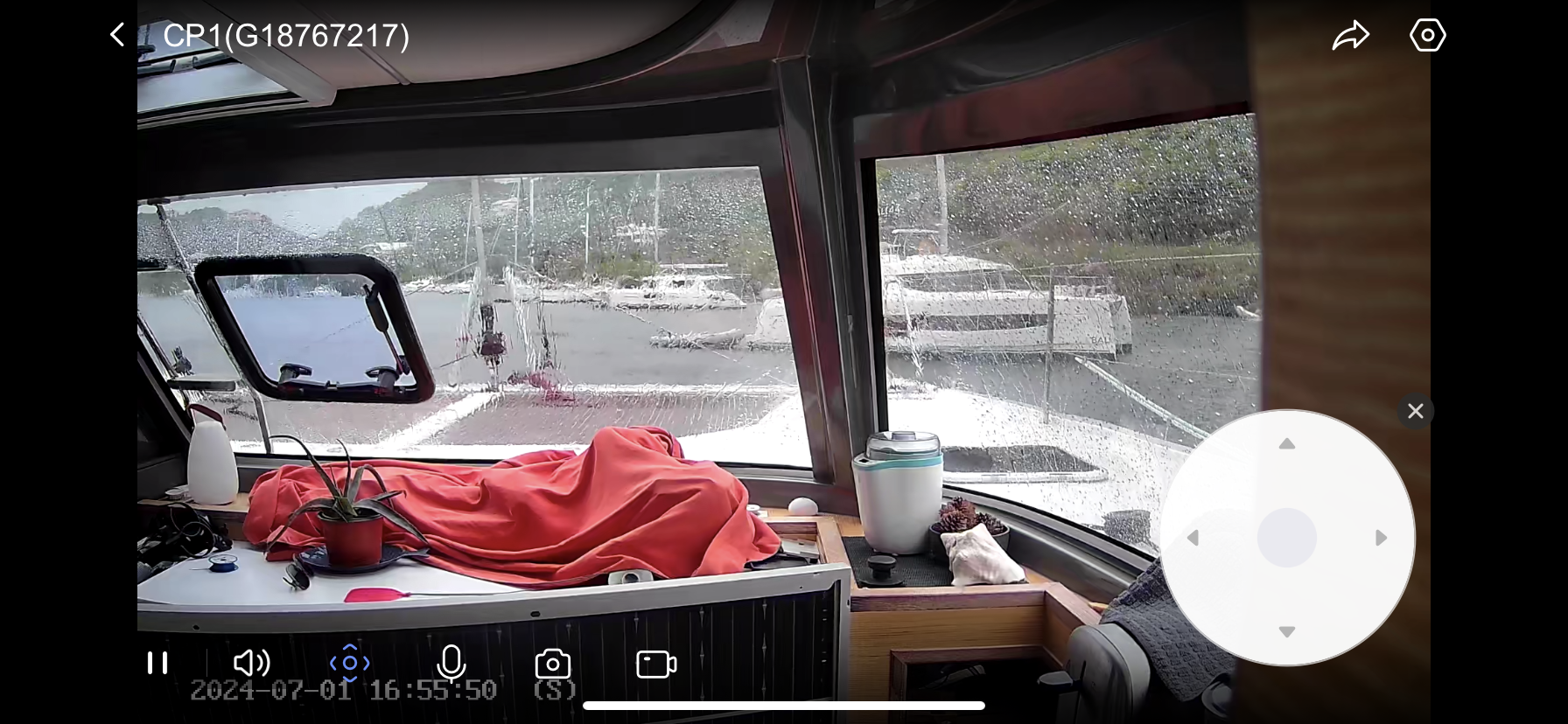
11am, here comes the wind. It built up very quickly and blowing hard, but not terrible. A few palm frond have come down and looking out we see there are some huge 5 meter waves breaking on the reef. Checking the camera Nauts seems to be ok too. We check the weather models and it looks like the eye is passing 30 miles north of us. It’s much closer than we’d like, but in the end went a bit further north than the worst case predictions. However, it’s this next period that is going to be most critical as we don’t have the hills of Grenada to protect us when the winds loops around on the back of the system.
12pm and it’s like somebody threw a switch and turn the fan up to max. The wind is howling, it’s raining hard and blowing horizontally. A few loud cracks as trees and branches came down near us and we can feel the roof vibrating and trying to lift off. As the wind continues to rotate to the south it’s blowing in and we have to close most of the shutters. The wind change also means the sea state is getting up and the waves are really pounding onto the beach and the marina (but fortunately there isn’t a storm surge).
We still have internet access and the starlink is working on the boat so we can check the CCTV. The good news is things seem to be much quieter in Egmont and the hurricane hole is doing it’s job.
It’s just a case of sitting and waiting now. It really is like you see on the news with and the wizard of oz, with things flying past the window as if gravity doesn’t really exist anymore. Looking at the weather models we should be in the worst of it now as the eye has passed and is moving away quickly.
After an hour the wind starts to drop down surprisingly quickly to something more reasonable and doesn’t gust back up. Another hour and it’s a strong wind, but doesn’t feel dangerous. I’m feeling caged up and want to have some sort of control again, so we decide to head back to the boat. Apparently there is a hurricane curfew, but we’re in the middle of nowhere, so we think we’ll get away with it or plead ignorance.
There are already people out starting to move fallen debris and cut through fallen trees. After a quick chat we hurry to where we have tied up the dingy. Over the top of the hill and we can see that Nautilus seems to be fine tied into the mangroves where we left her and there aren’t issues with the other boats…. Major relief… next we get to the bridge where we tied the dingy. Oops, we made a mistake there and had tied her directly under a road drain. She’s now overflowing with dirty water, but the tubes have kept her floating…. Pulling out the bung doesn’t really help, so I bale out with a rusty old paint can. A sore arm later and we’re back onboard Nautilus to check her over…. Amazingly no issues at all. We needed to tighten up a few lines, but that was it.

Hurricane passed, it took us a good few day to sort thing out and get back to normal, but we were lucky. The eye of Beryl passed directly over Carricau and pretty much destroyed it. The winds got up to 160mph, which made it a Category 5 hurricane. Union island has been flattened and since been evacuated and St. Vincent has taken a bettering too. It’s sobering as boats up there similar our have been picked up and flipped upside down or had their masts ripped of. Fortunately, there wasn’t a huge loss of life, but the locals have lost everything.
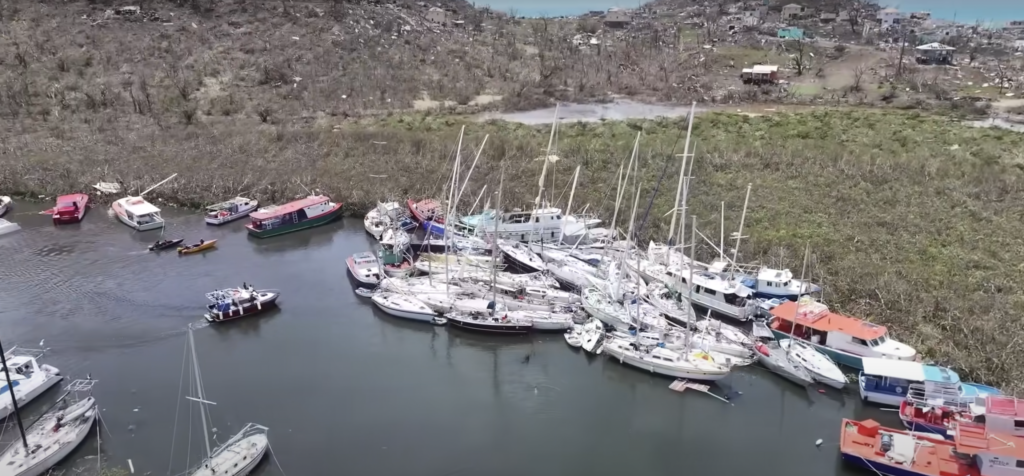

For us, if we look at outcomes made the right decision as we stayed and didn’t suffer any damage. The maximum reported wind speed in Egmont was about 40 knots and was likely less where we tied into to. At the marina where our apartment was, the max speed was 68knots (just shy of 80mph). But I find myself thinking “we were lucky”, what would have happened if the system had come further south and we saw winds even 20% stronger than they were.
On reflection, if we were in the same situation again, I think I would run away. One of the hardest things was the sitting and waiting. Also knowing that if the hurricane shifted just a few degrees one way or the other it could have a massive impact you and the survivability of your boat and your home. If we had moved south, we could have kept going further until you were way out the way. I also hadn’t fully appreciated the risk that your most likely source of damage would be other boats breaking free and dragging into you.
Listening to people describing the last major hurricane, that was the case for some boats in Egmont and there was a pile-up in roughly the same area we were tied into.
So I’m proud Tatum and I got through it and I’m very happy with how Nautilus performed. I think we prepared the best we could and our strategy of tying into the mangroves was robust. But it’s not something I would want to repeat again.